| Download Pricelist |
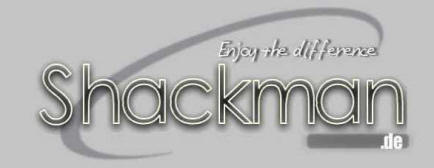 |
|
|
Reiner E. Römer Oberhausen, Germany Fn: +49 208 6351070 Fx: +49 208 6351071 |
||
|
|
 |
  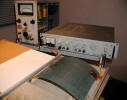 |
|||||||
Quad 63 DIY Quad57
Other Corporate Links:
DIY Quad ESL-57 !Original Coating!
! Looks uneven !
Corrosion, leakage Our high voltage modifications: screw connectors Available in our "Mods Package"
together with new HV wiring 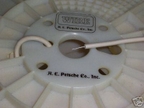 20kV HVcable in ESL57 and insulation lacquer 5kV/µ corona lacquer for HV connections 20kV HV bias wire reromanus mods, The ultimate way to QUAD ESL57 perfection. It is worth the effort. |
Get back your Hörfreude
QUAD ESL 57/63 repair, servicing and upgrading , finishing and refining ....
we master these matters ........
........up to matched conditions serial repair!
We keep your gems alive !Simply solder off the defective panels and send them in ! We also offer a special exchange service for defective panels.
Should your precious Quads possibly be refurbished? All Quad ESLs should be checked and renewed/refurbished regularly in order to avoid common failures. The sound is becoming duller and duller. Sparking and hissing occurs. But doing so regularly in a ten years interval will result in a crystal clear like new Quad sound quality. We also recommend to upgrade some special weak points in the Quad electronic features of the crossover, which very clearly improve all sound aspects of the ESL-63 speakers. See more information at the end of page.
Watch out!! Every once and a while we do have some speakers for sale. Naturally fully refurbished by us, means like new or even better. If you are desperately searching for a pair of the Quad ESL63 or ESL57, please give us a call and we will give you a reservation for the next available item. We also have single ESL63 spare panels/elements for sale. Please ask for a quote.
!Actual offers FOR SALE!
We also have two pairs of ESL57, fully refurbished with new cabling and all other modern new materials like glue, coating and diaphragm/dust-cover foil, as well as modern EHT unit. Like this one below for example, right after refurbishment.
The Knots of that Refurbish/Repair Thing The two pictures below show a DIY repair result. Even the damping mesh and the PCB are destroyed, due to unsufficiant stretching tension.
QUAD ESL63 Mechanical Stretching, the First Key to Perfection Below you see a well done repair by a pro company, although again with un-sufficient stretching. The mechanical diaphragm tension shows only half the value (left) than the original panel (right, black coating).
But actually most important is the danger of flapping and finally a "gluing" diaphragm during charging process . On the other hand, the sometimes recommended 2kg per strip tension is way too high. That will end up in too high a resonance frequency, resulting in too high a resonance frequency, and - by not fitting the passive input filter's parameters - in a boomy/hollow bass sound reproduction.
Electro-acoustical aspects of a correct tension Having had in hand several hundreds of Quad ESL panels/elements, I always measured the same resonance frequency at +/- 0 Hertz and thus the same mechanical tension at +/- 1 g/sq. To me, it is still a wonder, how that could be done at a real serial production, and, most important of all, keeping the same parameters after decades. But it is easily to understand, that this was the most important factor of the mechanical acoustical design of the Quads63, because one has to keep in mind, that there is a passive input filter in the electronic sector, exactly fitted to the mechanical parameters. So now everyone understands, how important it is, to realize the exact resonance frequency, when re-foiling the panels. Not hitting the exact resonance frequency would stringently mean having to change the values of the passive input filter ( R and C) to the appropriate new values. Not doing so - correct mechanical tension AND/OR attenuating the input filter - will result in a very "unQuad" sound, and, even more dangerous, very likely in a self-destroying electro-mechanical swinging system, awaiting new repair very soon. So this simple tension question seems to be the key to everything and you got it .... but not really, because the very most important is coming soon - in the next chapter (coating).
Easy but effective way for DIYers - not having a special gauge - to adjust the diaphragms' tension.
INFO: You can also realize the correct mechanical tension of a single ESL63 panel by simply measuring its acoustical resonance frequency by using your PC's audio card even with a very primitive microphone of any kind. Simply bat the foil with a pencil or the finger tips and you will see something like the picture below.
The side bands shown in this photo show also that there are multiple resonances (left one diagonal resonance, right one vertical resonance, mid one overall resonance), caused by the panels rectangular geometry. But most important of all is hitting the overall main resonance correctly.
Practical Aspects of Mechanical Foil Stretching An other aspect is the pre-stretching of the foil with a heat gun before doing the final mechanical stretching of the foil to the frames. We do that with all ESL speakers including Quad-57 and Quads-63. This is an additional working step, but is worth the results. Heat-gunning after the mechanical stretching and gluing process will result in massive loss of the desired tension because of the warming of the adhesive and molecular changes in the physical overall behaviour of the foil under extreme tension stress, (unless you calculated that factor correctly into the prior mechanical tension, depending on what kind of adhesive and foil type your are using).
Next simple aspects defining the ultimate fine art of ESL refurbishing would be: a.) doing the stretching work generally only under certain favorable atmospheric conditions (humidity/temperature), and b.) stretching as many panels as possible under the same atmospheric conditions. We do that as often as possible with a little "serial production" jig, where up to 4 panels can be stretched and glued at a time. And c.) Stretching as many panels as possible under one single tension process. Both aspects will result in nearly identically stretched Quad63 panels. That same procedure is used with Quad ESL57s as well.
Simple jig for stretching multiple panels simultaneously. The picture Above shows a "tension matched" pair (c.), and logically "condition- matched as well. Resonance-frequency will differ by 0Hz, they are fully identical. Below you see a quad of only "condition matched" panels (b.). But nevertheless the resonance-frequencies only differ by about 1 Hz because of precise individual tension gauging at the very moment of gluing the diaphragms to the front stators .
Quad ESL-63 Coating Technique, The Golden Key to Perfection The image below shows a wrong coating of the same
panel. It has the appropriate conductivity, but one can see very
well defined borders of highly concentrated coating liquid. That are
areas of higher conductivity which lets the charge keep moving
on the diaphragm . So the liquid has to be better distributed in
order to provide constant and stable charge to the whole diaphragm
area.
Below you see the Shackman method of coating multiple panels under the same atmospheric conditions. In this case, six panels are to be coated for simultaneous equal condition drying and curing.
Below: Masking for precise coating spraying of Quad ESL63
By the way....
A.)
The original ESL-63 has a bi-layer coating.
(see pictures below)
B.) The Quad ESL 57 has a single nylon layer of at least 8µ to 10µ as conductive coating. That brings up the question of the appropriate film with modern ultra thin coating liquids like e.g. the reromanus VLC liquids for refurbishing a defective panel. That means, it could be allowed to use thicker foils at least for the ESL63.
And further more the Quad ESL57 has a bass panel multi-layer dust cover film (the grey painted ones) of at least 15µ to 20µ (probably a silicon layer) . The purpose of that much of a thickness is not very easily to understand. Perhaps a passive radiator system, or an additional acoustical low pass filter, or both ?
After all, minimizing moving mass was not the main concern of Peter Walker on the ESL57s, instead minimum leakage was the main target. Interesting enough that later he switched to the opposite strategy with the ESL63s. All photos Copyright, Shackman.de, Reiner E. Römer
!!Simply solder the defective panels off your gems and send them in!!
Quad ESL-63 Surface Resistivity
Below you see the ideal value of surface resistivity of a well
coated diaphragm, measured with a calibrated DR.THIEDIG Milli-TO
2 with standardized VERMASON high resistance concentric ring
electrode probe at V_M =1000V. The resistivity is lower as one would
possibly assume. Test showed a slightly better behavior of the Quads
63 by using a slightly higher resistivity (1 to 1,5 power) than the
originally applied conductivity.
See above: Professional and scientific ring probe for standardized measuring of absolute surface resistivities "in vivo", The weight of the probe and the elasticity of the inner probe's ring's spring are normalized. This tool helps to give a repeatably reliant result "per square" See above. See below: For even more precise measurements of coatings "in vitro" and developing our coating knowledge, we use the Keithley ring probe adapter and Keithley 610 C Pico-Ampere electrometer combined with a 1 volt precise 5kV tube driven Philips/Fluke voltage source. See below.
Measuring the "real" surface resistivity of the original Quad ESL63 diaphragm. That is not "about" the resistance, that procedure really will show the exact "as is" value.
The "Knowledge feature"below is NOT yet implemented !
Quad ESL-63 Modifications
1. Modify the NF- INPUT-FILTER? There are many tales about upgrading and mods of the Quads - including a ! thicker! power line. We do not follow most of these activities ending up in ridiculous mods. But at least some modifications/improvements should be done while restoring an ESL63. That is changing the input network's electrolytic capacitors. Electrolytics change their attributes during time, including the capacity itself. Below you see a reromanus modification with 400V MKP SQ "AUDYN" type film capacitors in parallel with a "WonderCap". The idea of changing the wire resistor to a film type resistor makes not that much sense unless all other resistors in the NF-signal path right before the step up transformers are not changed as well. We recommend to keep the hands off from those resistors.
Nowadays, Mr.Walker surely would have used MKPs as well. But at that time these capacitors were not available and/or too large and expensive. They fit the correct size/price for that kind of modification only since a couple of years.
Please note!
2. No SUBWOOFER or "DiPoliThor"? Since the early 80s there are divergent opinions about the use of a subwoofer with the ESL63/57. There are pros and cons and there surely never will be a consent between the two parties. And until a a couple of years ago, we were part of the cons party. Despite having since more than 20 years a perfect and satisfying subwoofer system of our own, the DCS (Double Cavity) passive band-pass system with driver inside the cabinet and passive radiator outside. But now there is a very new solution shining up at the horizon for combining a full range ESL with an "open baffle" subwoofer. Perfect, because now both, the ESL and the Sub, are "open baffle" drivers, with the same impulse behavior. And that really sticks. We do think, that a subwoofer makes a lot of sense in cases, where the listener sometimes has the wish for more fundamental tones in its original sound level, like it is often done e.g. in mixing and recording sound studios world wide (Polygram, Tritonus, ETI, Dabringhaus, Straus). Keep in mind, that this can also avoid the possible destruction of the Quads by giving to much voltage level to the speakers. And you won't have the compression effects of the Quad63's power limiter electronics. Even the passive input filter (230µF ELCAP)could be realized in a much more effective way, but not by omitting it.
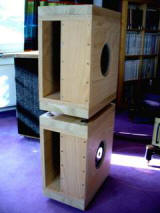
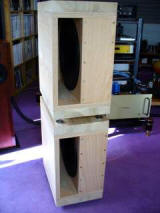 Right now, when being asked, we recommend a mechanically simple but electrically difficult "Dipole-Subwoofer" solution. To the opinion of most of the high-end people and to ours, it is right now the best subwoofer available - except perhaps a 10 meter unfolded lf horn- because of its absolute absence of "boxy" and hollow sound. It is giving a light, bright, natural and open bass perspective to that what is called "lively resonance-free bass fundament". without adding anything else but that what lacks with respect to the live impression. You can hear that very impressively listening e.g. to a "Bösendorfer Grand Piano" You will not miss a single impulse "attack" impression in the very counter A's . We will have our own solution for that principle, fully according to the special Quad requirements in the very near future. It will be names the the "DipoliThor". But , actually , unfortunately we cannot do anything else but recommending to search the web for "Dipole woofer" or "Ri-Pol woofer" (Ri-Pole is a special German engineered dipole subwoofer construction from Freiburg/Brsg). Or ask for our schedule and mile stones for that "Dipolithor" Subwoofer development. Right now we are hoping for finishing that project in the early autumn weeks. Listening sessions will be possible very soon. Please call for listening sessions. The "DiPoliThor" will be available both, as Mono-subwoofer ( placed somewhere in the middle of the stereo axis) and as Stereo subwoofer (attached to the ESL directly). Adaption to your special room acoustics are possible and probably necessary as well.
3. Modern and better High Voltage cables and insulation? That is a thing, that should or can be done for best refurbishing results for both, the 63 and, even more and nearly a must, the 57. Because one thing is clear - The more isolation and better contact you have, the less HV, either from the EHT or from the step up transformer, is going away to nirvana, despite coming from the best amp o the world. We have very flexible cable, white silicon rubber jacket, 30kV insulation. The center conductor is 20 AWG, 19 strand, silver plated, Overall diameter is not less than 4mm. No single electron will pass its way through that isolation. Unbeatable for everlasting results -And- It gives the kick to the last bits of something like unnatural "buzzing harshness" (see chapter Mylar PET foil contra Hoechst PP PHD somewhere else) in the mid-highs of the 57/63 Quads listening to some of the well known and very special vinyl (and CD as well ) recordings. The photo below shows the way we are wiring and insulating the Quad ESL57 at all possible joints. The HV bias is directly connected to the panels without additional soldering points. By this way any leakage is avoided to a maximum degree and nearly eternal live is given to the electrical section of the ESL-57 speakers Quad_grill-cloth_colours
Available Spare Parts for Quad ESL
Spare parts in stock: ESL63 vertical grill stiffeners ESL63 the metal grills itself Spare step-up transformers QUAD ESL63 stands Dust cover frames Complete delay line PCBs Step-up transformer EHT unit
Right now we have for sale and in stock 3 pairs of fully refurbished QUAD ESL63s and two pairs of Quad ESL57 Please ask for a quote for the above items
By far the most unusual modification to an
original unchanged Quad ESL63 panel we ever got in our hands
was this one below.
Copyright all photos Shackman.de, Reiner E. Römer
4. Dust cover film type Another modification is the best choice of the type of dust cover foil to be used. Read about that some lines above and on the DIY repair/refurbish page.
Conclusion: Trust in our experience and facilities. You will be satisfied. No costs for checking. Best lasting results guarantied. It will pay.
QUAD 57/63 repair and upgrading .... ........we master these matters
!!Simply solder the defective panels off your gems and send them in!! Service fully guaranteed!!
You can also join the SHACKMAN Discussion Group Actual SHACKMAN eBay auctions Online |
Speakers will be repaired by Chief Reiner E. Römer Other Corporate Links:
Most common failures Quad 63 Original Resistivity
Stretching jig as winding device
Heavy weight gluing
Stretching "from the roll"
Resistivity calibration
Assembly workshop
DIY Coating ESL-57
To be continued in the left column
Speakers will be repaired by Chief Reiner E. Römer Other Corporate Links:
Speakers will be repaired by Chief Reiner E. Römer Other Corporate Links:
Speakers will be repaired by Chief Reiner E. Römer Other Corporate Links:
Speakers will be repaired by Reiner E. Römer Other Corporate Links:
reromanus Audio Literature Database Actual Offers on eBay
Speakers will be repaired by Chief Reiner E. Römer Other Corporate Links:
Speakers will be repaired by Chief Reiner E. Römer Other Corporate Links:
|
||||||
|
Reromanus Shackman |

